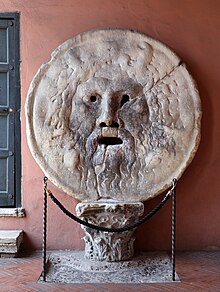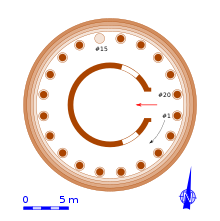Temple of Hercules Victor
 The Temple of Hercules Victor, in the Forum Boarium | |
 Click on the map for a fullscreen view | |
| Coordinates | 41°53′19″N 12°28′51″E / 41.8887°N 12.4808°E |
|---|---|
The Temple of Hercules Victor (
Despite (or perhaps due to) the Forum Boarium's role as the cattle market for ancient Rome, the Temple of Hercules is the subject of a folk belief claiming that neither flies nor dogs will enter the holy place.[3] The temple is the earliest surviving mostly intact marble building in Rome and the only surviving one made of Greek marble.[4]
Description
Dating from the later 2nd century BC and erected by
The original wall of the cella, built of
Identification

Its major literary sources are two almost identical passages, one in
Post-Classical history

In the 1st century AD, the temple was hit with some sort of disaster as 10 columns were replaced with Luna marble, which is similar to the original but not an exact replica.
Additional restorations (and a
In the 17th century, the church was rededicated to Santa Maria del Sole ("St. Mary of the Sun"). The temple and the Temple of Vesta in
See also
- Hercules in Roman religion
- Ara Maxima
- Temple of Portunus
- List of Ancient Roman temples
References
Citations
- ^ Barton Sholod, "Charlemagne in Spain. The Cultural Legacy of Roncesvalles", p. 144
- ^ "...houses built into the round Temple of 'Vesta', which de Tournon correctly identified as of Hercules Victor, were removed" in 1811 (Salmon 1995, 150).
- , trans. James Leoni (1755), p. 117.
- ^ "Temple of Hercules". World Monuments Fund. Retrieved 2019-12-15.
- ^ For its dating, see Ziolkowski 1988, 314ff; Ziolkowski's argument for its dedicator and criticisms of other scholars' candidates: 316ff.
- S2CID 164402027.
- S2CID 164402027.
- S2CID 164402027.
- ^ sed Romae victoris Herculis aedes duae sunt, unam ad Portam Geminam, alia ad Forum Boarium.
- ^ Noted by Ziolkowski 1988:309 and notes; the other temple was that of Hercules Invictus ad Circum Maximum.
- ^ Adam Ziolkowski 1988:311 and note 6 demonstrates the interchangeability that developed for the two originally separate epithets.
- ^ "Temple of Vesta/Hercules, Rome". World History Encyclopedia. Retrieved 2019-12-15.
- ^ "Temple of Hercules". World Monuments Fund. Retrieved 2019-12-15.
- ^ "Temple of Vesta/Hercules, Rome". World History Encyclopedia. Retrieved 2019-12-15.
- S2CID 108832442.
- ^ See Alessandro Pergoli Campanelli, Restauro del cosiddetto Tempio di Vesta, in "AR", XXXV, 32, novembre-dicembre 2000, pp. 26-30.
Sources
- Alberti, Leone Battista. Architecture, 1755, tr. Leoni, James.
- Claridge, Amanda. Oxford Archaeological Guides - Rome. Oxford University Press, 1998
- Coarelli, Filippo. Guida Archeologica di Roma. Arnoldo Mondadori Editore, Milano, 1989.
- Salmon, Frank (1995). "'Storming the Campo Vaccino': British Architects and the Antique Buildings of Rome after Waterloo". S2CID 158291335.
- Woodward, Christopher. The Buildings of Europe - Rome. page 30, ISBN 0-7190-4032-9
- Ziolkowski, Adam (1988). "Mummius' Temple of Hercules Victor and the Round Temple on the Tiber". JSTOR 1088657.
- Loar, Matthew Hercules, Mummius, and the Roman Triumph in Aeneid 8.” Classical Philology, www.journals.uchicago.edu/doi/10.1086/689726.
External links
- Detailed photographs of the interior and features of the building
- High-resolution 360° Panoramas and Images of Temple of Hercules | Art Atlas
- Lucentini, M. (31 December 2012). The Rome Guide: Step by Step through History's Greatest City. Interlink. ISBN 9781623710088.
![]() Media related to Temple of Hercules (Rome) at Wikimedia Commons
Media related to Temple of Hercules (Rome) at Wikimedia Commons
| Preceded by Temple of Hadrian |
Landmarks of Rome Temple of Hercules Victor |
Succeeded by Temple of Janus |


